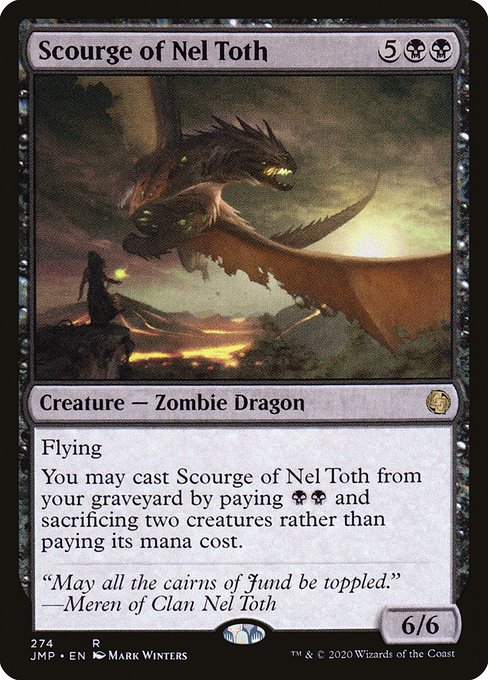
Image courtesy of Scryfall.com
Rarity vs Mana Cost: Scourge of Nel Toth as a Case Study
In the sprawling universe of Magic: The Gathering, there’s a subtle romance between rarity and mana cost. Scourge of Nel Toth, a rare from Jumpstart, crystallizes this relationship in a way that veteran players instantly recognize: big numbers, big dreams, and a surprising amount of trickery packed into a single card. With a mana cost of 7 (5 generic and 2 black) and a formidable presence on the battlefield, this is the kind of creature you stare at and think, “Yep, that tracks for a rare.” 🧙♂️🔥
First, let’s pin down what this card actually does. Scourge of Nel Toth is a Creature — Zombie Dragon with flying, a stat line of 6/6, and a highly unusual ability that bends the normal rules of casting. It reads: you may cast this creature from your graveyard by paying {B}{B} and sacrificing two creatures instead of paying its mana cost. That means you’re trading immediate mana investment for a reanimation engine that can swing the game if you’ve built the deck to sustain the graveyard. This kind of cost hedge—pay BB plus two bodies in exchange for a powerful re-emergence—illustrates why black cards, especially zombies and reanimate themes, often ride the line between “fun but risky” and “game-ending with the right setup.” 🧩🎲
Why Rarity Still Matters at a 7-CMC Creature
Rarity isn’t just about scarcity in print; it’s a signal about expected power, design space, and the kinds of archetypes a card is meant to support. Jumpstart, as a set, emphasizes replays of familiar strategies—rummaging through the graveyard, exploiting resource-rich boards, and presenting bold finishes in draft-friendly environments. A rare with a high mana cost like Scourge of Nel Toth packages both a sense of inevitability and a “you’ll want that in your deck” pull. The card’s rarity communicates: this is not a throwaway beater; it’s a strategic engine that can reshape late-game planning when your graveyard is active and your board is ready to capitalize on the flight and evasion. 🔥💎
Yet the exploit is balanced by the graveyard-activation clause. The ability to bypass the mana tax using BB and two sacrifices is not a cheap trick; it demands timing, tempo, and sacrifice outlets. It’s a textbook example of how rarity and mana cost interact: the card’s power is deliberately gated behind a cost that discourages casual, pay-full-price usage. In practice, you can leverage this reanimation rhythm with fetchers, tutors, and stalwart zombie synergies to flood the board or close out games when the graveyard becomes a second hand you can always play from. This is where the card design earns its keep—the cost is high, the payoff is dramatic, and the deck-building angle feels satisfying rather than oppressive. 🧙♂️⚔️
Flavor, Lore, and the Design Ethos
The flavor text—“May all the cairns of Jund be toppled.” — Meren of Clan Nel Toth—cements the card’s place within a broader black-green-black narrative around necromantic reclamation and the long shadows of Nel Toth. Mark Winters’ artwork channels a dread presence suited to a dragon of the graveyard’s deepest corners, while the multi-layered identity of the card aligns with MTG’s enduring fascination with “pay heavy, get heavy” gameplay—which often lands best in multiplayer formats where long games become epic trials of resources and timing. The rarity label here is an invitation to invest in a specific kind of strategic moment: the one where the graveyard becomes a gold mine and a threat that opponents must answer, or else watch a dragon rise again and again. 🎨🧭
Strategic Play: Building Around the Seed
In practical terms, Scourge of Nel Toth shines in graveyard-centric decks, particularly those that lean into reanimation and recursion. You’ll want to ramp toward big mana while simultaneously packing sacrifice outlets and ways to refill your graveyard with value. The card’s Flying nature also interacts nicely with evasive threats and bombs that can ignore ground blockers, letting you pressure life totals even in slower games. It’s a natural candidate for zombie tribal or broader black-centered strategies that value resource attrition and late-game workups. In formats where you can leverage the graveyard as a resource, the Scourge’s re-casting clause is a potential game-winner, especially when combined with payoffs that reward repeated plays from the grave. 🧠🧪
From a collector’s perspective, the card’s condition and rarity contribute to its value on secondary markets. While nonfoil versions are readily accessible and typically budget-friendly (around a few dollars in casual circulation), the card remains a vivid symbol of how rarity guidelines interplay with mana costs. The Jumpstart print is a reminder that Wizards of the Coast uses rarity to help manage expectations for power creep and design space, even when a card can look deceptively straightforward at first glance. For players who enjoy reanimator antics or zombie-centric decks, Scourge of Nel Toth is a “buy now, think later” kind of pick—if you believe in the power of a big finisher that can be resurrected with style. 💎🧟♂️
Phone Case with Card Holder Glossy Matte PolycarbonateMore from our network
- https://blog.digital-vault.xyz/blog/post/how-un-set-visuals-shaped-soul-strings-in-mtg/
- https://transparent-paper.shop/blog/post/how-to-create-printable-quote-collections-that-inspire/
- https://blog.digital-vault.xyz/blog/post/basim-ibn-ishaq-parody-cards-mtg-investment-potential-unveiled/
- https://transparent-paper.shop/blog/post/bright-35000-k-star-in-centaurus-defies-precise-measurements/
- https://blog.digital-vault.xyz/blog/post/extremely-reddened-hot-giant-at-2-kpc-traces-stellar-associations/